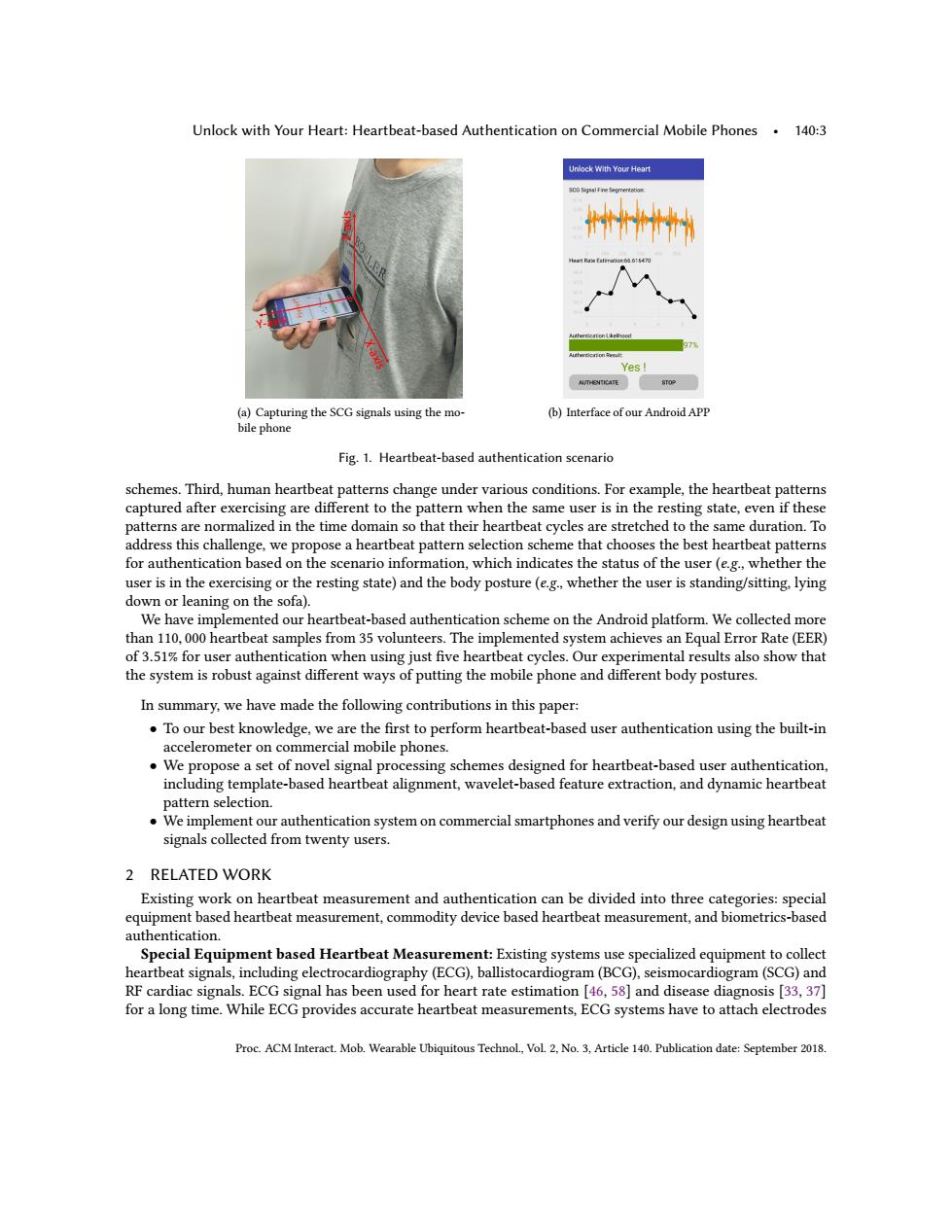正在加载图片...

Unlock with Your Heart:Heartbeat-based Authentication on Commercial Mobile Phones.140:3 Unlock With Your Heart Yes! (a)Capturing the SCG signals using the mo- (b)Interface of our Android APp bile phone Fig.1.Heartbeat-based authentication scenario schemes.Third,human heartbeat patterns change under various conditions.For example,the heartbeat patterns captured after exercising are different to the pattern when the same user is in the resting state,even if these patterns are normalized in the time domain so that their heartbeat cycles are stretched to the same duration.To address this challenge,we propose a heartbeat pattern selection scheme that chooses the best heartbeat patterns for authentication based on the scenario information,which indicates the status of the user(e.g.,whether the user is in the exercising or the resting state)and the body posture(e.g.whether the user is standing/sitting.lying down or leaning on the sofa). We have implemented our heartbeat-based authentication scheme on the Android platform.We collected more than 110,000 heartbeat samples from 35 volunteers.The implemented system achieves an Equal Error Rate(EER) of 3.51%for user authentication when using just five heartbeat cycles.Our experimental results also show that the system is robust against different ways of putting the mobile phone and different body postures. In summary,we have made the following contributions in this paper: To our best knowledge,we are the first to perform heartbeat-based user authentication using the built-in accelerometer on commercial mobile phones. We propose a set of novel signal processing schemes designed for heartbeat-based user authentication, including template-based heartbeat alignment,wavelet-based feature extraction,and dynamic heartbeat pattern selection We implement our authentication system on commercial smartphones and verify our design using heartbeat signals collected from twenty users. 2 RELATED WORK Existing work on heartbeat measurement and authentication can be divided into three categories:special equipment based heartbeat measurement,commodity device based heartbeat measurement,and biometrics-based authentication. Special Equipment based Heartbeat Measurement:Existing systems use specialized equipment to collect heartbeat signals,including electrocardiography(ECG),ballistocardiogram(BCG),seismocardiogram(SCG)and RF cardiac signals.ECG signal has been used for heart rate estimation [46,58]and disease diagnosis [33,37] for a long time.While ECG provides accurate heartbeat measurements,ECG systems have to attach electrodes Proc.ACM Interact.Mob.Wearable Ubiquitous Technol.,Vol.2.No.3,Article 140.Publication date:September 2018.Unlock with Your Heart: Heartbeat-based Authentication on Commercial Mobile Phones • 140:3 Z - a xis X-axis Y-axis (a) Capturing the SCG signals using the mobile phone (b) Interface of our Android APP Fig. 1. Heartbeat-based authentication scenario schemes. Third, human heartbeat patterns change under various conditions. For example, the heartbeat patterns captured after exercising are different to the pattern when the same user is in the resting state, even if these patterns are normalized in the time domain so that their heartbeat cycles are stretched to the same duration. To address this challenge, we propose a heartbeat pattern selection scheme that chooses the best heartbeat patterns for authentication based on the scenario information, which indicates the status of the user (e.g., whether the user is in the exercising or the resting state) and the body posture (e.g., whether the user is standing/sitting, lying down or leaning on the sofa). We have implemented our heartbeat-based authentication scheme on the Android platform. We collected more than 110, 000 heartbeat samples from 35 volunteers. The implemented system achieves an Equal Error Rate (EER) of 3.51% for user authentication when using just five heartbeat cycles. Our experimental results also show that the system is robust against different ways of putting the mobile phone and different body postures. In summary, we have made the following contributions in this paper: • To our best knowledge, we are the first to perform heartbeat-based user authentication using the built-in accelerometer on commercial mobile phones. • We propose a set of novel signal processing schemes designed for heartbeat-based user authentication, including template-based heartbeat alignment, wavelet-based feature extraction, and dynamic heartbeat pattern selection. • We implement our authentication system on commercial smartphones and verify our design using heartbeat signals collected from twenty users. 2 RELATED WORK Existing work on heartbeat measurement and authentication can be divided into three categories: special equipment based heartbeat measurement, commodity device based heartbeat measurement, and biometrics-based authentication. Special Equipment based Heartbeat Measurement: Existing systems use specialized equipment to collect heartbeat signals, including electrocardiography (ECG), ballistocardiogram (BCG), seismocardiogram (SCG) and RF cardiac signals. ECG signal has been used for heart rate estimation [46, 58] and disease diagnosis [33, 37] for a long time. While ECG provides accurate heartbeat measurements, ECG systems have to attach electrodes Proc. ACM Interact. Mob. Wearable Ubiquitous Technol., Vol. 2, No. 3, Article 140. Publication date: September 2018